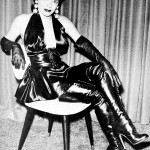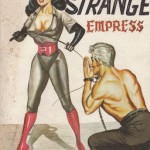There was a certain odd gap in my research. I had plenty of material on the Victorian era: Munby and Cullwick, Sacher-Masoch, Krafft-Ebing and My Secret Life, just to name a few things. After WWII there’s Willie, Stanton and Bilbrew, the biker/leatherman culture, L’Histoire de O, the Profumo scandal and so on.
But what happened in kink in the Interwar period? There’s the Weimar Republic of Germany, as documented by Mel Odom’s Voluptuous Panic. I also want to work in William Charles Moulton and his creation, Wonder Woman. And what else?
Furthermore, what happened in America all those years before the 40s? Why was the US apparently so vanilla compared to Europe?
Jay A. Gertzman’s Bookleggers and Smuthounds: The trade in erotica, 1920-1940 (University of Pennsylvania, 2002) helps a lot. It covers a strange era in US history when Americans grappled with the issue of what is permissible in print, which Europeans had dealt with generations before. The main axis of conflict is between immigrant pornographer and “pariah capitalist” Samuel Roth, and John Saxon Sumner, the more polite and reflective successor to the great American censor, Anthony Comstock.
Gertzman’s divides the erotic book trade into five categories: gallantiana, sex pulps (set in the here and now), erotology and sexology, “bibles” and “readers” (cheap paperbacks), and classical and modern books “judged to be rankly indecent.” (Pg. 61)
Gallantiana, a term coined by Gershon Legman, is “those marginal elements of unexpurgated literature such as jest-books and balladry, works on (and against) women and love, facetious treatises in prose and in verse, and the hinterland of scatologica.” (Pg.62) This included Beardsley’s Under the Hill, Venus in Furs and other works that had, or tried to have, a certain upper-class grace.
General “flagitious” books are where you’d find our old friends Fanny Hill, the Marquis de Sade, Burton’s Perfumed Garden and others.
Most of the books on flagellation seem to have been sexology works, or passed off as such, and were openly sold instead of under the counter. The mail order catalogs of the Anthropological Library of Jersey City, New Jersey, and New York City have lengthy sections on flagellation. It looks like the censors didn’t even contsidered flagellation as sexual until the mid-30s. The books were usually advertised as being for collectors of curiosities, physicians, lawyers and sexual researchers. Psychopathia Sexualis was one of these books. Another was Dr. Maurice Chideckel’s Female Sex Perversion: The Sexually Aberrated Female as She Is, published by Eugenics Publishing Company, first published in 1935. The advertisement shows a nude, nubile woman clinging to a female statue while Cupid despairs. Chideckel’s writing style wasn’t what you’d call scientific, and the book is illustrated profusely, including beautiful women whipping and being whipped.
Gargoyle Press was the major purveyor of “Books on Corporal Punishment,” according to the advertisements, with copy like “Remarkable stories of Whippings inflicted on both sexes, disclosing the strange grip the Rod has had on men and women since the beginning of Time.”
I’m curious that there doesn’t seem to be a body of flagellation literature native to the US that doesn’t have the academic camouflage; no American counterpart of Swinburne or Sacher-Masoch. Is this because of different disciplinary traditions in the US versus the UK and European nations? Was there no school punishment tradition in the Americas?



